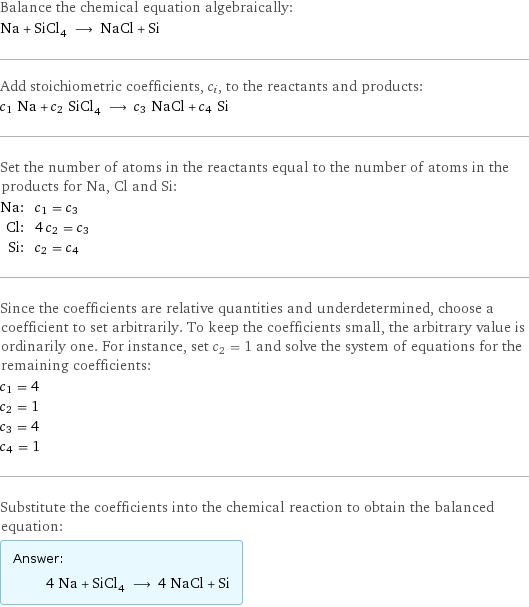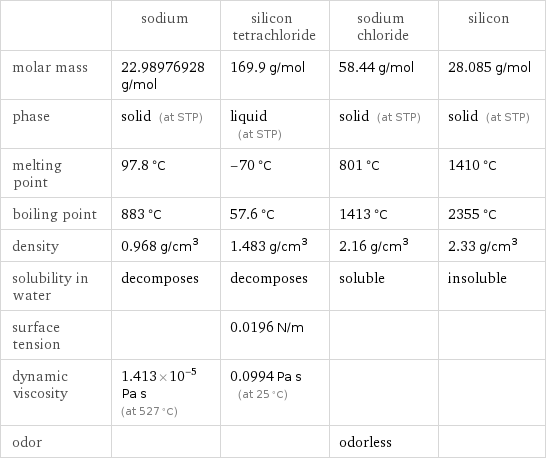Input interpretation

Na sodium + SiCl_4 silicon tetrachloride ⟶ NaCl sodium chloride + Si silicon
Balanced equation

Balance the chemical equation algebraically: Na + SiCl_4 ⟶ NaCl + Si Add stoichiometric coefficients, c_i, to the reactants and products: c_1 Na + c_2 SiCl_4 ⟶ c_3 NaCl + c_4 Si Set the number of atoms in the reactants equal to the number of atoms in the products for Na, Cl and Si: Na: | c_1 = c_3 Cl: | 4 c_2 = c_3 Si: | c_2 = c_4 Since the coefficients are relative quantities and underdetermined, choose a coefficient to set arbitrarily. To keep the coefficients small, the arbitrary value is ordinarily one. For instance, set c_2 = 1 and solve the system of equations for the remaining coefficients: c_1 = 4 c_2 = 1 c_3 = 4 c_4 = 1 Substitute the coefficients into the chemical reaction to obtain the balanced equation: Answer: | | 4 Na + SiCl_4 ⟶ 4 NaCl + Si
Structures

+ ⟶ +
Names

sodium + silicon tetrachloride ⟶ sodium chloride + silicon
Equilibrium constant
![Construct the equilibrium constant, K, expression for: Na + SiCl_4 ⟶ NaCl + Si Plan: • Balance the chemical equation. • Determine the stoichiometric numbers. • Assemble the activity expression for each chemical species. • Use the activity expressions to build the equilibrium constant expression. Write the balanced chemical equation: 4 Na + SiCl_4 ⟶ 4 NaCl + Si Assign stoichiometric numbers, ν_i, using the stoichiometric coefficients, c_i, from the balanced chemical equation in the following manner: ν_i = -c_i for reactants and ν_i = c_i for products: chemical species | c_i | ν_i Na | 4 | -4 SiCl_4 | 1 | -1 NaCl | 4 | 4 Si | 1 | 1 Assemble the activity expressions accounting for the state of matter and ν_i: chemical species | c_i | ν_i | activity expression Na | 4 | -4 | ([Na])^(-4) SiCl_4 | 1 | -1 | ([SiCl4])^(-1) NaCl | 4 | 4 | ([NaCl])^4 Si | 1 | 1 | [Si] The equilibrium constant symbol in the concentration basis is: K_c Mulitply the activity expressions to arrive at the K_c expression: Answer: | | K_c = ([Na])^(-4) ([SiCl4])^(-1) ([NaCl])^4 [Si] = (([NaCl])^4 [Si])/(([Na])^4 [SiCl4])](../image_source/c4a79712212375d4150c657db557afcb.png)
Construct the equilibrium constant, K, expression for: Na + SiCl_4 ⟶ NaCl + Si Plan: • Balance the chemical equation. • Determine the stoichiometric numbers. • Assemble the activity expression for each chemical species. • Use the activity expressions to build the equilibrium constant expression. Write the balanced chemical equation: 4 Na + SiCl_4 ⟶ 4 NaCl + Si Assign stoichiometric numbers, ν_i, using the stoichiometric coefficients, c_i, from the balanced chemical equation in the following manner: ν_i = -c_i for reactants and ν_i = c_i for products: chemical species | c_i | ν_i Na | 4 | -4 SiCl_4 | 1 | -1 NaCl | 4 | 4 Si | 1 | 1 Assemble the activity expressions accounting for the state of matter and ν_i: chemical species | c_i | ν_i | activity expression Na | 4 | -4 | ([Na])^(-4) SiCl_4 | 1 | -1 | ([SiCl4])^(-1) NaCl | 4 | 4 | ([NaCl])^4 Si | 1 | 1 | [Si] The equilibrium constant symbol in the concentration basis is: K_c Mulitply the activity expressions to arrive at the K_c expression: Answer: | | K_c = ([Na])^(-4) ([SiCl4])^(-1) ([NaCl])^4 [Si] = (([NaCl])^4 [Si])/(([Na])^4 [SiCl4])
Rate of reaction
![Construct the rate of reaction expression for: Na + SiCl_4 ⟶ NaCl + Si Plan: • Balance the chemical equation. • Determine the stoichiometric numbers. • Assemble the rate term for each chemical species. • Write the rate of reaction expression. Write the balanced chemical equation: 4 Na + SiCl_4 ⟶ 4 NaCl + Si Assign stoichiometric numbers, ν_i, using the stoichiometric coefficients, c_i, from the balanced chemical equation in the following manner: ν_i = -c_i for reactants and ν_i = c_i for products: chemical species | c_i | ν_i Na | 4 | -4 SiCl_4 | 1 | -1 NaCl | 4 | 4 Si | 1 | 1 The rate term for each chemical species, B_i, is 1/ν_i(Δ[B_i])/(Δt) where [B_i] is the amount concentration and t is time: chemical species | c_i | ν_i | rate term Na | 4 | -4 | -1/4 (Δ[Na])/(Δt) SiCl_4 | 1 | -1 | -(Δ[SiCl4])/(Δt) NaCl | 4 | 4 | 1/4 (Δ[NaCl])/(Δt) Si | 1 | 1 | (Δ[Si])/(Δt) (for infinitesimal rate of change, replace Δ with d) Set the rate terms equal to each other to arrive at the rate expression: Answer: | | rate = -1/4 (Δ[Na])/(Δt) = -(Δ[SiCl4])/(Δt) = 1/4 (Δ[NaCl])/(Δt) = (Δ[Si])/(Δt) (assuming constant volume and no accumulation of intermediates or side products)](../image_source/d9a935a8233299b93cbe8bcca231fc49.png)
Construct the rate of reaction expression for: Na + SiCl_4 ⟶ NaCl + Si Plan: • Balance the chemical equation. • Determine the stoichiometric numbers. • Assemble the rate term for each chemical species. • Write the rate of reaction expression. Write the balanced chemical equation: 4 Na + SiCl_4 ⟶ 4 NaCl + Si Assign stoichiometric numbers, ν_i, using the stoichiometric coefficients, c_i, from the balanced chemical equation in the following manner: ν_i = -c_i for reactants and ν_i = c_i for products: chemical species | c_i | ν_i Na | 4 | -4 SiCl_4 | 1 | -1 NaCl | 4 | 4 Si | 1 | 1 The rate term for each chemical species, B_i, is 1/ν_i(Δ[B_i])/(Δt) where [B_i] is the amount concentration and t is time: chemical species | c_i | ν_i | rate term Na | 4 | -4 | -1/4 (Δ[Na])/(Δt) SiCl_4 | 1 | -1 | -(Δ[SiCl4])/(Δt) NaCl | 4 | 4 | 1/4 (Δ[NaCl])/(Δt) Si | 1 | 1 | (Δ[Si])/(Δt) (for infinitesimal rate of change, replace Δ with d) Set the rate terms equal to each other to arrive at the rate expression: Answer: | | rate = -1/4 (Δ[Na])/(Δt) = -(Δ[SiCl4])/(Δt) = 1/4 (Δ[NaCl])/(Δt) = (Δ[Si])/(Δt) (assuming constant volume and no accumulation of intermediates or side products)
Chemical names and formulas

| sodium | silicon tetrachloride | sodium chloride | silicon formula | Na | SiCl_4 | NaCl | Si Hill formula | Na | Cl_4Si | ClNa | Si name | sodium | silicon tetrachloride | sodium chloride | silicon IUPAC name | sodium | tetrachlorosilane | sodium chloride | silicon
Substance properties

| sodium | silicon tetrachloride | sodium chloride | silicon molar mass | 22.98976928 g/mol | 169.9 g/mol | 58.44 g/mol | 28.085 g/mol phase | solid (at STP) | liquid (at STP) | solid (at STP) | solid (at STP) melting point | 97.8 °C | -70 °C | 801 °C | 1410 °C boiling point | 883 °C | 57.6 °C | 1413 °C | 2355 °C density | 0.968 g/cm^3 | 1.483 g/cm^3 | 2.16 g/cm^3 | 2.33 g/cm^3 solubility in water | decomposes | decomposes | soluble | insoluble surface tension | | 0.0196 N/m | | dynamic viscosity | 1.413×10^-5 Pa s (at 527 °C) | 0.0994 Pa s (at 25 °C) | | odor | | | odorless |
Units
